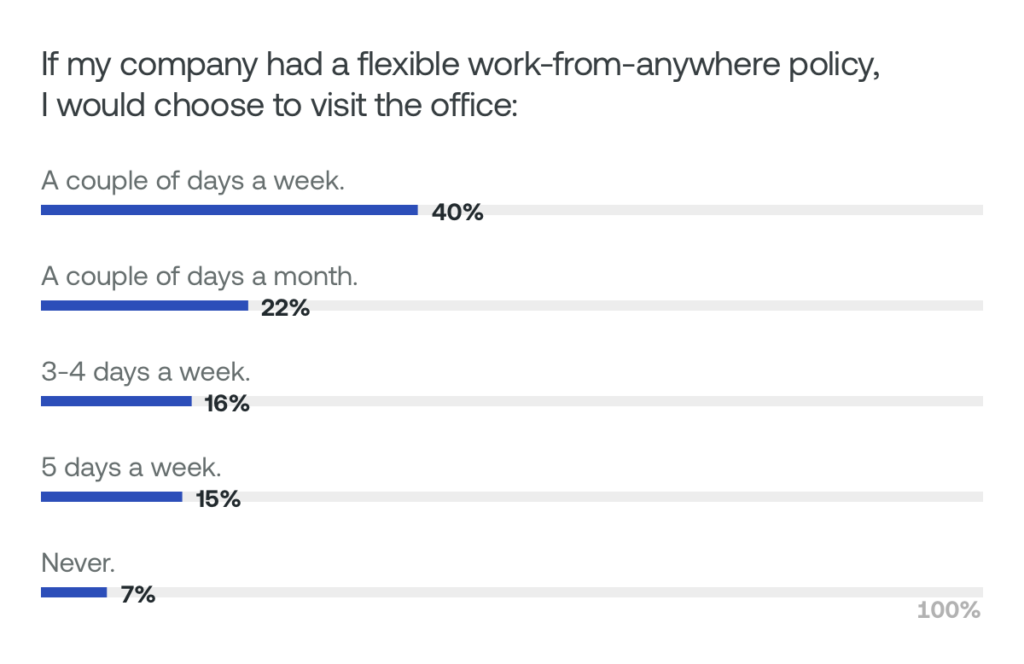The work from home movement has been going strong for more than a decade now.
Remote workers who love it appreciate the freedom and flexibility. Some view it as a sign of respect from an employer that trusts them to remain professional in any setting. Others enjoy avoiding a lengthy commute.
But remote work doesn’t have to be an all-or-nothing proposition. Even office workers dream of working in their pajamas once in awhile. Companies are increasingly embracing policies that allow remote workers to come to the workplace sometimes and office employees to do their job from home on certain days.

Support for such arrangements can be seen in the results of our recent workplace experience survey. We asked 100 workers for their preferences and learned that people who usually work in the office also want to work from home sometimes.
Specifically, we asked workers how often they would visit the office if their company fully embraced a work-from-anywhere policy.
An overwhelming 85% preferred not to come to the office everyday. The most popular response, chosen by 40% of respondents, was to go to the office “a couple of days a week.” But 15% say they would still come in five days per week, and a similar number (16%) would opt for “3-4 days a week.” Just 7% replied that they would “never” come in to the office, while 22% elected for “a couple of days per month.”
Companies that build out appealing spaces and smartly invest in the right amenities may be more likely to employ people who actually want to show up at the office everyday.
Interestingly, there seems to be a link between people’s desire to come to the office and how much they enjoy their workplace.
About one-third of employees who “strongly agree” with the statement “I am fully satisfied with the design and amenities of my office” replied that they would chose to come in 5 days a week regardless of company policy. By contrast, 20% of those who “strongly disagree” with this statement would only come in a couple of days per month, and around 12% of these respondents say they would never go to the office.
While this survey was limited in size, these findings could have important implications for workplace design. Companies that build out appealing spaces and smartly invest in the right amenities may be more likely to employ people who actually want to show up at the office everyday.
Remote work has increased by 140% since 2007 among non-self-employed workers.
Overall, these response shouldn’t surprise anyone who has been following workplace trends. The five-day work week might not be dead, but according to Global Workplace Analytics, more than one-third (37%) of knowledge workers now come into the office four or fewer times per week. In all, 43% of employed Americans occasionally work remotely, and remote work has increased by 140% since 2007 among non-self-employed workers.
But we could have guessed employees enjoy working from home. What do companies think?
Well, in fact, we continue to see evidence that remote work is great for both sides. A two-year study by Stanford professor Nicholas Bloom, for example, showed that workers at Shanghai travel agency Ctrip were much more productive at home. The company almost got an equivalent of an extra day of work per week from each employee.
The employees at the company also took fewer sick days and shorter breaks. Attrition fell by 50% among the work-from-home group. And Ctrip was even able to reduce office space, saving around $2,000 on rent per remote employee.
Another factor contributing to the rise of remote work is that it opens the talent pool. At Density, for example, we have used this as a tool to hire much-needed specialists. When the required skill that a company is seeking is not widely available in their local market, broadening the search to faraway locations can be the best — or even only — way to get the right person.
But there are some downsides as well. As we have seen in our survey, workers still do view the workplace as essential for collaboration and getting certain types of work done. And they do enjoy their overall job experience much more when their office is well designed and equipped with nice amenities. Losing out on that entirely could have negative consequences when it comes to certain projects or just overall morale.
This is one reason that some organizations have begun to look for ways to ensure that their culture and workplace collaboration can be encouraged.
One option that some have used is hosting more regular social and team-building events. While these can become tedious — or even loathed — if the execution is poor, a good work retreat can excellent for both employee bonding and encouraging deep conversations about the larger department goals that can get pushed to the back burner during the day-to-day grind of deadlines and project deliverables.
Other companies have gone digital. Some have started offering company “water cooler” Slack channels or Facebook-variant networks that allow people to share photos of their family, pets, vacations, or hobbies. CNN Business recently noted that “employees are randomly paired up once a week to hold a 30-minute video chat” at Zapier, a California-based tech company that maintains a majority remote workforce.
Such initiatives will never fully replicate face-to-face connections. But they can present a way for people to get know their coworkers a bit better despite seeing one another infrequently.
Ultimately, even though the two concepts may seem at odds, today’s employees want to both work from home and work in a good office environment.
Naturally, nobody can do both at the same time. But companies that are able to optimize their space as well as their remote work policies are the most likely to keep their employees happy and productive — no matter where the work is being accomplished.
